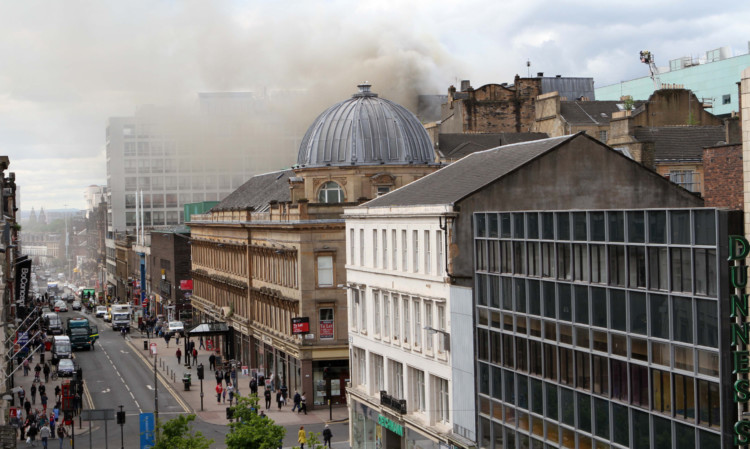
A sprinkler system was just weeks away from being installed in Glasgow’s art school when flames ripped through the building.
Art school bosses were set to install sprinklers that could have helped put the catastrophic blaze out in minutes.
The Sunday Post has learned the final phase of a new “fire suppression system” installation was due to begin in June. It was ordered amid fears the historic building was becoming a tinderbox.
However the art school, which is partly funded by the taxpayer, struggled to attract the finance needed to complete the project.
Ironically, as news broke yesterday that the school’s iconic library had been ruined in the fire, government ministers declared they would be making a significant donation towards the costs of renovating the building.
Chief Secretary to the Treasury Danny Alexander said it would contribute “in the millions, if necessary” to restore the “priceless gem”.
The Scottish Government’s Culture Secretary Fiona Hyslop added: “We have already invested heavily in the school in recent years, contributing around £55m to the new Reid building and to conservation of the Mackintosh building. “We know the restoration will run into millions of pounds, and we are committed to strongly supporting the funding effort required.”
The timing of the announcement wasn’t lost on artist and art promoter Richard Demarco.
He said: “The building is like Scotland’s Sistene Chapel. Every part of it is a work of genius, a real one-off. The Mackintosh library, in particular, is irreplaceable. We have lost something priceless.
“Having spent £55 million on a new building they should have spent whatever it takes to get a sprinkler system in the Mackintosh building before now.
“Every square-inch should have been safe-guarded and it’s inexcuseable if penny-pinching got in its way.”
The art school’s last annual report, published in 2013, said work had started on the installation of the fire suppression system.
In its planning application to Glasgow City Council, officials at the school said the building had “been subjected to over 100 years use of paint, chemicals etc soaking into the fabric which undoubtedly has increased flammability.”
The project involved the construction of pipes throughout the building that would spray a high pressure “mist” in the event of a fire and would be “completed during the next academic year”.
But the system was not in operation on Friday, just weeks away from the launch of the end-of-year degree show on June 14.
Minutes from a meeting of the art school board in October 2012 also reveal the school had struggled to raise money for the project.
The notes stated it had “been difficult in the present financial climate to secure the final donations required”.
As a result, the school had explored possible ways of paying for it “at a cost low enough to be covered by donations already secured”.
Lesley Booth, of Glasgow School of Art, insisted there was no set deadline for completion of the system.
She said: “There has never been a sprinkler system in the building. We had fire procedures in place that were what you would expect in a grade A-listed building.
“We were in the process of installing a fire suppression system. It was a bespoke one being created especially for that building.”
She added: “We were due to do the next phase in the summer which would have been the final phase. We had to raise the money through philanthropic giving. There is no deadline on this kind of project. You’re working in a grade-A listed building. ”
Eyewitnesses have said the fire started when a spark from a projector caught a piece of foam used in an art exhibit. The school refused to comment on the possible cause yesterday, stating it is now the subject of an investigation.
Broadcaster Muriel Gray, who is the art school’s chairwoman, lamented the loss of the library but said she was pleased other features had been saved.
She said: “We have lost the iconic, and unique Mackintosh library. This is an enormous blow and we are devastated. But the almost miraculous news is that the majority of the building is still intact.
“Due to one of the most astonishingly intelligent and professional pieces of strategy by the fire services, they succeeded in protecting the vast majority of the building, apparently by forming a human wall of fire-fighters up the west end of the main staircase and containing the fire.”
Chief Secretary to the Treasury, Danny Alexander, said: “We can make contributions in the millions if necessary.”
The money will come from underspends across Whitehall departments added the Scots Lib Dem cabinet minister.
A Scottish Government spokesperson said: “This is clearly a matter for the institution. We understand that GSA had a fire protection system in place that was suitable for an A-listed building.”
Traumatised students at are being offered counselling after the fire gutted their work.
Over 600 students are due to finish their course this year but last night many appeared to be in limbo.
A spokeswoman said: “Our top priority is looking after the students. We are setting up counselling at the moment for students who need it.
“We will be looking at the next three weeks between now and the degree show and how we support the on-going work of the school.
“We will support those students whose work has been destroyed in the fire.”
By John Paul Breslin, Gordon Blackstock and Iain Harrison

Enjoy the convenience of having The Sunday Post delivered as a digital ePaper straight to your smartphone, tablet or computer.
Subscribe for only £5.49 a month and enjoy all the benefits of the printed paper as a digital replica.
Subscribe